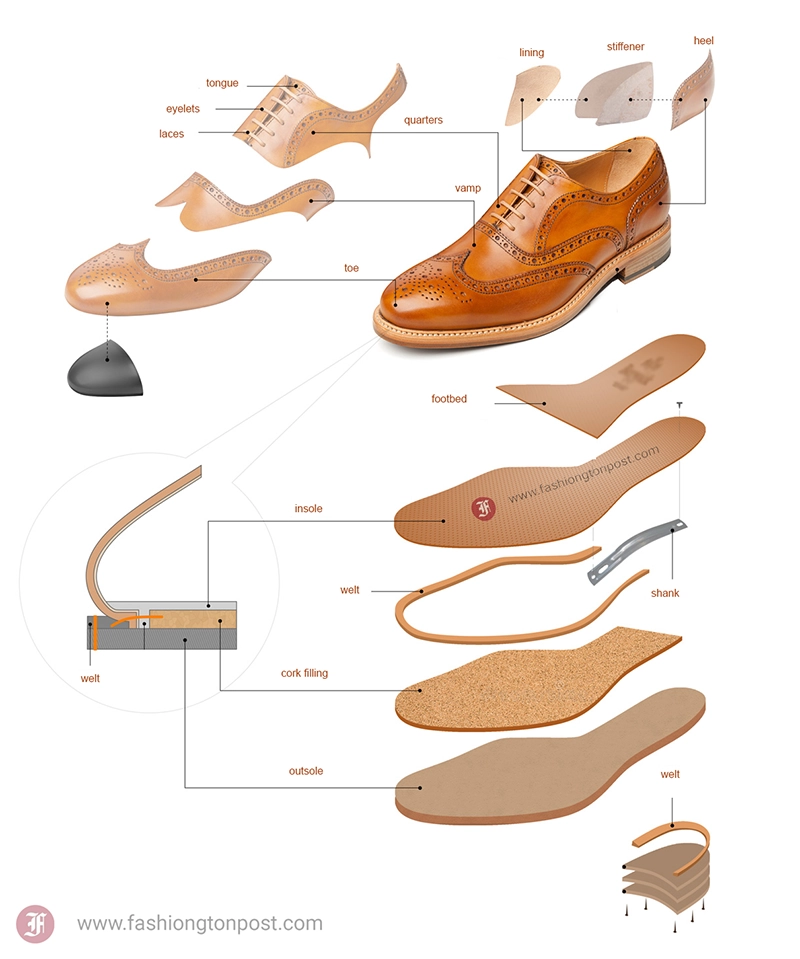
Shoes have a complex anatomy that contributes not only to their aesthetic appeal but also to their functionality and comfort. The Fashiongton Post decided to take a closer look at the various components that make up the anatomy of shoes and unravel the secrets behind their design.
Upper
The upper part of a shoe wraps around the foot and plays a crucial role in determining the shoe’s style and fit. It’s typically made from a variety of materials, including leather, canvas, mesh, or synthetic fabrics. The upper encompasses everything above the sole and includes components like the vamp (front part), quarters (sides and back), and the tongue.
Vamp
The vamp is a crucial part of the upper that covers the top of the foot, extending from the toe box to the eyelets. It contributes significantly to the overall appearance of the shoe and plays a role in providing structure and support.
Sole
The sole is the foundation of any shoe, providing support, durability, and traction. It consists of two main parts – the outsole and the midsole. The outsole is the bottom layer that comes into direct contact with the ground, while the midsole, located between the outsole and the insole, contributes to cushioning and shock absorption.
Insole
Located inside the shoe, the insole is the interior component that your foot rests on. Insoles are designed for comfort and can be removable or permanently attached to the shoe. They often incorporate various materials, such as foam or gel, to enhance support and alleviate pressure on the feet.
Heel
The heel is the rear part of the shoe that elevates the back of the foot. Heels come in various styles and heights, ranging from flat to high, and can significantly impact both the aesthetic and functional aspects of the shoe. Some shoes feature block heels, stilettos, wedges, or platforms, each contributing to a distinctive look.
Shank
The shank is a supportive structure between the insole and outsole, usually found in the midfoot area. It enhances the shoe’s stability and prevents excessive bending, offering support to the arch of the foot. Shanks can be made from various materials such as metal, plastic, or fiberglass.
Toe Box
The toe box is the front portion of the shoe that encases the toes. It can vary in shape and size, influencing the overall design and comfort of the shoe. Rounded, pointed, or square toe boxes are just a few examples of the diverse options available in the world of footwear.
Welt
The welt is a strip of material, often leather or rubber, that runs along the perimeter of the outsole. It serves as a connection between the upper and the sole, contributing to the overall durability and strength of the shoe. Welted construction is a hallmark of high-quality, durable footwear.
Eyelets and Laces
Eyelets are the small holes along the sides of the shoe that hold the laces in place. Laces not only secure the shoe on the foot but also contribute to the overall style. The arrangement of eyelets and the way laces are threaded can add a touch of uniqueness to the shoe’s design.
Understanding the intricate components of your shoes will allow you to appreciate the craftsmanship and design that goes into creating the perfect pair. Step out with confidence!
The post Anatomy of Shoes appeared first on The Fashiongton Post.
